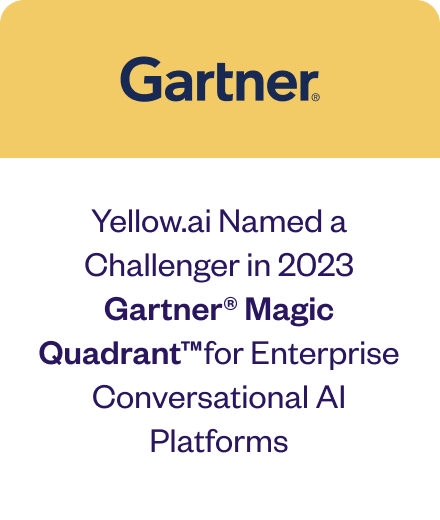D2C commerce is becoming more popular, where we are seeing brands not only establishing one direct channel, but multiple. More channels, always means more reach and more spread. At Yellow.ai, we help the brands launch their Conversational Commerce channel with our new D2C Commerce Assistant – Canary.
Why Conversational Commerce?
In addition to the obvious gains that D2C gives you(like cutting middlemen commissions), D2C is a preferred channel for brands mainly also because of the following 3 reasons:
1. Branding is made strictly consistent – from language to experience:
2. Lets the brands to understand their customer & customer relationship
3. Reduces Time to market
We, at Yellow.ai, strongly believe that ‘Conversations’ are the best communication tools. It may sound very obvious, but the perception that we have created towards Web UI & Window UI that it is intuitive, is fundamentally wrong. Humans have been effectively communicating through ‘conversations‘ for thousands of years, where as modern interfaces are just two or three decades old. Unprecedented adoption of Instant Messaging Applications like WhatsApp for Business is a standing testimonial to the organic nature of this UX: From a Brand’s perspective, Conversational Commerce Channel helps in faster launch, standard experience and increased reach. Let me take you through how Canary can help the brands to redefine their customer lifecycle. Before that, let us understand about customer lifecycle a little bit.
What is Customer Lifecycle?
Customer Lifecycle (CLC) comprises of various stages of interaction between customers and your brand. It starts right when they find or get to know about your product or services, to becoming a lifetime customer. The idea of understanding customer lifecycle lets you identify potential ways to progress a customer from one phase to the next phase. Brands know that Customer lifecycle is one of the important aspects of customer relationship management(CRM) because it helps to increase Customer Lifetime Value(CLV), which is the most important metric to measure in commerce. Remember, loyal customers are not only high CLV customers, but they equally help in acquiring new customers, who also, at most of the times, end up becoming loyal to the brand.
Stages of Customer lifecycle
For a D2C brand, we can safely classify the customer lifecycle to 5 stages:
1. Awareness and Acquisition
Reach out to your prospect – inbound & outbound. Technically, if a customer has a need, and you have a product to satisfy that, he is your prospect. Usually, acquiring customer happens in two methods:
a) Push / Outbound / Passive: In this method, customers are proactively reached out. Most of the times, this is on a paid channel, and involves paid marketing.
b) Pull / Inbound / Active: In this, customers often search for the product, and end up discovering your product. This can be done by various platforms that creates visibility, like Google Search, Listing on Marketplaces, etc. This is very effective, and often will have more success rate in conversion, because the customer is actively looking out for a product. He is a very well qualified lead.
Lets see how Canary helps your acquisition and awareness stage:
Reaching out to customers – Push
1. Conversational Campaigns with Campaign Manager: 1-way notifications are done and dusted. Customers know what is a click bait. Notifications should have a clear to call to action, that not only redirects, but interacts with the customers and understand them more.
2. Ads with Conversational CTAs on Social Media: Brands can reach out to the customer through any of the channels mentioned below, with a conversational CTA – leading to one of the messaging channels. Once the customers are taken to a messaging channel, he will be able to go ahead and explore the products. Customers can continue forward with the notification sent, and enter into product discovery Canary helps you send interactive notifications through the following channels:
1. Notifications on Facebook Messenger
2. Voice Blast
3. Transactional Campaigns on Whatsapp
4. Web Push Notifications
5. Ads on Facebook, Instagram
6. SMS, Email
Make the product discoverable – Pul
For a customer who is searching for your brand or a product by your brand, you should make them discoverable. With Yellow.ai, make your brand ‘reachable’ to millions of customer through these powerful channels:
1. Conversational Landing Pages/Banners: Conversational Landing pages/Banners do the work of advertising your product/feature/offer and also takes care of clarifying customer’s queries and measures the customer’s interest on the same. This can also be coupled with the traditional
2. Google Business Messaging: Google search is the place where majority of searches happen. Make your brand or product discoverable through Google Business Messages. Once enabled, whenever the customer searches for the brand/nearby store, a click to message button pops up, through which Canary engages with the customer. This is becoming very popular and brands are realizing the potential of it.
3. Apple Business Chat: Apple lets the customer to discover the brand through their tools like Siri, Safari, Apple Maps, iMessages. From there, Apple business chat can be launched, and the platform is quite interactive, with lots of UI options which are not present on other channels. It also lets your customers pay through Apple Pay
4. Google Feeds: You can list the product on Google, by uploading it in Google Feeds, which when clicked, will navigate you to the chatbot, with the context set to the product.
5. QR Code to WhatsApp: QR code landing from WhatsApp is a very welcome move from WhatsApp for all D2C commerce brands. These QR codes can let your customers land into WhatsApp from various places – Packaging boxes, Store shelves, Digital Ads, Physical Ads, etc.
Google Business Messaging, is undoubtedly one of the best ‘visibility’ solutions out there. This is relatively new to market, and know more about how you can leverage for your business here. QR Code by Whatsapp is a whole new way to reach out to a customer in whatsapp.
2. Conversion
Get the customer to buy once. Once the customer knows that there are product[s] for his need from you, he analyses the product, does his research, and evaluates his decision before making his choice. Its very important to provide a seamless experience to the customer, and this is where your Brand & shopping experience can be crucial. Customers do not only buy the product, but also the experience that you give him/her.
1. Conversational shopping experience with Retail NLP: Customers, especially millennials and Gen-Z tend to enjoy chatting more than any other UI. And we also see that conversational channels are better suited for shopping experience, since it is possible to replicate the experience that off-line store assistant creates. Ask right questions, and narrow down the choice, interrupt wherever required to suggest the best product for the customer. While you can guide the user through the shopping flow, it is possible to land the customer at a right product, with the query he asked for. We support all popular messaging channels out there:
1. WhatApp Business
2. Facebook Messenger
3. Yellow.ai PWA — Standalone
4. Yellow.ai SDK for iOS & Android
5. Google Assistant, Alexa
6. Telegram, Viber, Line
2. Guided Flow: Customer can go through the buying experience, that brand knows best for their product. Custom filters and multi-level categories can be configured according to the brand’s preference. NLP: Bot can understand NLP query that customer enters, and can suggest the right product.
3. Suggestive selling: Suggesting the customer with a right product is also very important in the sales process. This helps the customer overcome the bias of choice and hand holds the customer incase of any product queries. Product solves a customer’s pain, or problem. AI assistants like Canary can effectively help customers identify the right product for their problem.
4. Abandoned Cart recovery & surveys. Cart recovery helps recover atleast 10% of customers who leave the shopping experience, which can be due to multiple reasons – product mismatch, pricing, complex UX, or just that customer would have forgot it. Canary helps you recover your cart, by doing multiple attempts of notifications. Most of the time, the notifications are conversational and intriguing in nature – which not only lets convert the cart, but also helps to understand why customer is not happy converting.
5. Analytics that speaks: Canary comes with conversational analytics to help understand the chatbot performance and consumer behaviour. Chatbots enables users to express whatever customer wants, which helps us understand more about the user, and we often find that ‘conversational analytics is way accurate and powerful than click analytics’. Customer saying ‘I want a black shoe‘ is much more an insight than customer clicking on a similar product.
3. Delivery
The product or service purchased is delivered & customer to be onboarded For D2C brands, sale is not considered complete till customer gets onboarded with the product or service that is sold. Making sure the delivery experience, onboarding experience is seamless is also the main reasons why brands go D2C.
1. Conversational Order updates: Keeping customer in dark is the last thing that you want to do to mess up your CRM & CS. Customers always will need to know what is happening to their order. This should be both proactive and reactive. It also helps in creating the trust in the channel, and becomes one-place stop for all brand communications.
2. Appointment Management: Appointment management is necessary when you sell a service. It is a problem that still is not that effectively solved by conventional UI so far. With canary, talk like a consultant and book your appointments. Proactively communicate with your customers to make sure the appointment is on, and utilisation is max!
3. Conversational Back-office for Order management: Managing orders and tracking delivery has not always been easy for the store managers and warehouse managers so far. With Canary, give your store managers ‘Conversational Store Manager’ access and see how they like it. Best part is, it can be enabled on any conversational channel, or as a light-weight PWA link.
Store managers are comfortable with Conversational Assistants which can help them do order management, since the navigation complexity is taken out and only ‘what is next’ is provided. Very soon, this will evolve into automating the Order management.
4. Retention
Get feedback, Engage and try selling more. After the customer has successfully recieved the product, the next activity is to understand if their experience with ordering, delivery and product were great, and try to fix if something has gone wrong. Since lot of parties would have been involved in the delivery, its very necessary to get the feedback from the customer.
1. Customer Satisfaction Survey: Canary comes with set of pre-configured surveys, which lets you understand how you did on various important factors and perspectives. Our surveys are also NLP driven, with customer sentiment detection. This helps us to perfectly understand how you did, and incase a negative sentiment is found, we use the power of human touch by transferring it to a live agent. Best and last chance to correct your mistake and retain the customer even in not-so-best cases.
2. Product feedback: For a D2C Brand, getting the feedback is very important, especially in the early stages of the product or new releases of variants. The feedbacks are unfiltered and establishes direct communication between the customer and the brand manager. Asking for feedback is more effective, when it is asked at the right time. Canary lets you decide the time interval after which feedback should be asked post delivery.
3. Product Onboarding: Product onboarding is required for few line of products. Canary lets you set up FAQs for your products and also enable how-to ‘SOPs’ for better and quicker onboarding of customers. The trigger point here can be
a) Customer reaching out to Canary – through QR codes in packaging
b) Canary reaching our post delivery
c) Canary Scheduling a virtual ‘demo’ upon delivery
4. Subscription: Regular purchase can be converted into Subscriptions during two phases – During checkout and After Checkout. Probe to convert your existing buyers and current customers into subscription, with intervals, that suit your product. Incentivizing the customer for a subscription is found very effective in conversion.
5. Advocacy and loyalty
Convert the customer into a promoter. It is always easy to sell to an existing customer, rather than to a new customer. The already-customer is registered, has experienced your buying journey and is coming back because he also liked the product you served. Acquisition costs are a huge factors for Brands, and the business is benefitted if one-time customers become loyal customers.
1. After sales support: For D2C brands, providing after sales support is also equally important to make sure the customer is becoming a lifetime customer. Since the customer bought it in same channel, its very obvious to reach out to support in the same channel. It can be as simple as ‘how to use this product’ to ‘this product is not working’. While the brands decide what will be the end action, depending upon the category they are in, it is very important to analyse how people use the product and what are the common issues people face. Canary lets you build Product FAQs, Service center locators and issue resolution
2. Live chat support: There can be moments where the query is beyond the chatbot’s intelligence to solve. Canary comes with Live agent dashboard, where customer service agents can resolve the queries – in this process, they also end up training the chatbot to answer this question for the next time.
3. Social sharing: Sharing a good experience is always fun, and making your customer share the experience that you created for them to buy the product is one of the best outcomes that your channel can ever bring. Canary allows you to share the shopping experience across social media channels.
4. Coupons, Loyalty and Referrals: Generating besst coupons based on customer’s preferences and likelihood of getting converted is very important. Incentivizing your customers through Referrals are definitely one of the most effective tools to acquire more customers. With Canary, Seamlessly enable referrals, with the combination of Social Messaging Channels.
One example of effectively using social sharing and referrals to increase acquisition and loyalty at the same point. It is always a Win-win! The interesting part in customer lifecycle is that it does’nt have to be essentially from point a to b. It can be from any stage to any other stage, primarily because:
1. Brand launches new products frequently, which can be to different segments.
2. Subscription based services can go straight from acquisition to loyalty
3. Lifecycle can start from retention stage in case of freemium model
Having a virtual assistant throughout the journey is something most brands think as a no-brainer and that is what we have built. Canary is your virtual assistant throughout your brand’s customer lifecycle. Reach out to us to super-charge your Customer lifecycle by perfecting the moments that matter!





















